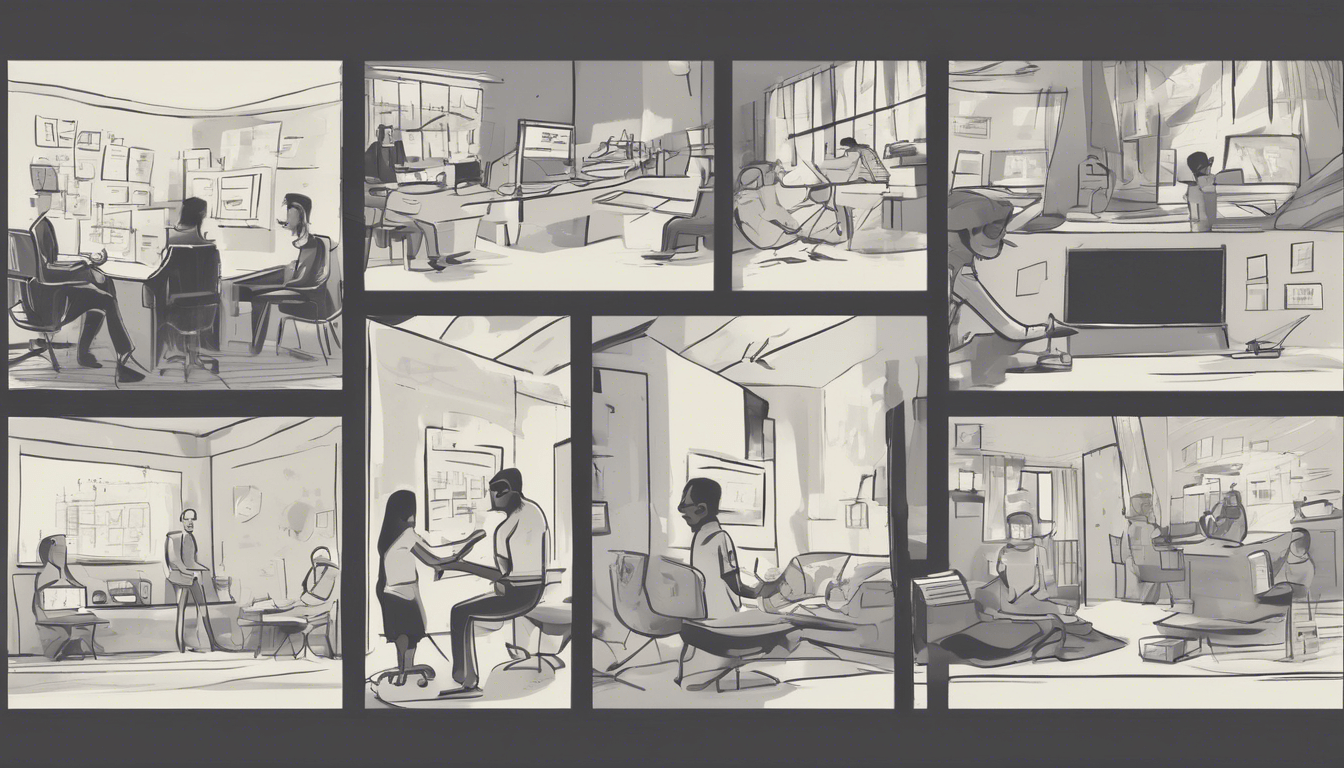Creating an inspiring video starts with a compelling storyboard—your blueprint for captivating viewers. This guide reveals how strategic visual elements, narrative flow, and emotional cues transform simple scenes into powerful storytelling tools. By exploring essential techniques, practical steps, and design tips, you’ll learn how to craft storyboards that not only evoke emotion but also inspire action. Discover how the right combination of imagery, color, and pacing elevates your message and truly resonates with your audience.
Understanding the Elements of an Inspiring Video Storyboard
Creating an inspiring video storyboard hinges on mastering several core elements that work together to engage and motivate viewers. At its heart, a video storyboard is a visual roadmap that outlines each scene, combining imagery, text, and flow to tell a compelling story.
In parallel : Create a video storyboard that engages and inspires
First, key visual elements must evoke emotion. This means selecting images and colors that resonate deeply with the intended audience. For example, warm tones such as reds and oranges can inspire passion and energy, while cool blues tend to evoke calm and trust. Thoughtfully chosen visuals serve as emotional triggers that make content unforgettable.
Equally critical is establishing a clear narrative flow. This involves structuring the storyboard’s sequence logically—beginning with an attention-grabbing opening, followed by a buildup of ideas or challenges, and culminating in a rewarding resolution. A seamless storytelling technique keeps viewers engaged and leads them to the intended call to action without confusion.
Also to see : What Are the Best Strategies to Revolutionize Marketing Practices for UK Businesses?
Additionally, the interplay of color, imagery, and text enhances the motivational impact. Color schemes should complement the story’s tone and help emphasize key points. Images add context and spark imagination, while concise, well-placed text supports clarity and reinforces messaging without overwhelming the visuals. Together, these components ensure that each scene drives the narrative forward and strengthens the overall emotional connection.
By focusing on these critical aspects—emotional visuals, clear storytelling, and harmonious design—creators can develop an inspiring video storyboard that not only informs but truly inspires audiences. If you want to explore how to put these concepts into practice, consider resources like https://playplay.com/product/video-storyboard, which provide practical guidance to craft storyboards that engage and motivate effectively.
Essential Techniques for Crafting an Engaging Video Storyboard
Understanding key storytelling principles to elevate your video projects
Establishing a Narrative Framework
Creating an effective video storyboard starts with a solid narrative framework. This involves clearly defining the story’s beginning, middle, and end, ensuring there is a logical flow that guides viewers seamlessly through the content. The narrative framework sets the foundation for every scene and shot, helping communicate the intended message with clarity and purpose. By outlining the core message early, you create a roadmap that keeps your video storyboard focused and engaging.
Incorporating Emotional Cues and Visual Metaphors
To deepen viewer engagement, it’s essential to integrate emotional cues and visual metaphors into your storyboard. Emotional cues involve planning scenes that resonate on a human level—whether through facial expressions, tone, or situational context—invoking feelings such as joy, empathy, or curiosity. Visual metaphors enrich storytelling by using imagery that symbolizes broader concepts or emotions, making complex ideas more relatable. For example, showing a wilting plant to suggest decline or rejuvenation to signal growth adds layers of meaning to your storyboard. These techniques ensure the storyboard is not only informative but also memorable.
Balancing Text and Imagery for Maximum Impact
A successful video storyboard strikes the right balance between text and imagery. Too much text can overwhelm viewers, while too few words risk leaving the narrative unclear. Effective storyboards distribute text strategically—using concise captions, dialogue, or on-screen instructions that complement visuals without overshadowing them. Alongside this balance, pacing and smooth transitions between scenes are critical to hold viewer interest. Well-paced cuts and thoughtful transitions prevent monotony, keep the story dynamic, and help maintain attention throughout. This balance ultimately turns your storyboard into a compelling guide for content creation.
Practical Steps for Designing Your Inspiring Video Storyboard
Creating an inspiring video storyboard begins with setting clear objectives that align with your desired emotional impact. Identify what message you want the audience to take away and how you want them to feel. This focus helps direct every choice throughout the storyboard creation process.
Next, select visual layouts that effectively guide viewer emotions. For instance, arrange scenes to build anticipation, then deliver a powerful reveal or call to action. Using layouts that strategically control pacing and transitions enhances engagement and reinforces your inspiring theme.
To streamline development, utilize templates and digital tools designed specifically for storyboard creation. These resources often include pre-built visual frameworks and customizable elements, allowing you to efficiently craft your video narrative while maintaining a professional look. Employing software solutions can save time and help you iterate quickly until your storyboard perfectly captures your vision.
By focusing on objectives, visual structure, and purpose-built tools, you ensure that your storyboard not only inspires but also communicates your message with precision and emotional resonance.
Visual Layout Tips and Best Practices
Mastering visual layout is essential for crafting a compelling storyboard that truly engages and inspires your audience. Arranging scenes thoughtfully creates a seamless narrative flow, making complex ideas easier to understand. Focus on the logical progression of scenes to build a cohesive story—this guides viewers naturally from one point to the next without confusion or distraction.
Establishing a clear visual hierarchy directs attention to the most critical elements. Use size, contrast, and placement strategically to highlight key messages or emotions. For instance, larger images or bold titles capture the eye immediately, while smaller, secondary details support the main content without overwhelming it. This careful balance keeps the storyboard engaging and focused.
Color and font choices profoundly impact the storyboard’s tone and effectiveness. Select colors that evoke the desired emotional response and maintain harmony across scenes. Choose fonts that are both readable and reflective of the story’s mood—whether bold and dynamic or soft and inspirational. Consistency in these elements is crucial; it reinforces your message and enhances clarity, ensuring viewers remain immersed.
Maintaining clarity and consistency throughout the storyboard reduces cognitive load, allowing viewers to absorb the content effortlessly. Repeat key design motifs and use a unified style guide to align every frame visually. This approach not only elevates inspiration but also solidifies the storyboard as a powerful storytelling tool for conveying your vision. For practical guidance on structuring your visuals effectively, check out https://playplay.com/product/video-storyboard.
Examples and Templates to Facilitate Inspiration
Unlock your creativity with ready-to-use resources
Analyzing successful inspiring videos and storyboards reveals common elements that drive engagement: a clear narrative arc, emotional resonance, and strategic pacing. These examples serve as practical models for shaping your own storyboard, ensuring your video captivates its audience from start to finish.
When seeking templates, consider both free and paid resources. Free templates offer accessibility and can jumpstart your storyboard process, allowing basic customization for your message. Paid options often provide more sophisticated designs, detailed layouts, and flexible formats, which can better align with professional storytelling goals. Using varied template resources balances ease and quality in your project development.
Customizing templates is key to transforming a generic outline into a unique story. Focus on modifying text, adjusting sequence flow, and incorporating brand elements. This personalization ensures your storyboard reflects your message and vision clearly. With tools like https://playplay.com/product/video-storyboard, you can create a video storyboard that engages and inspires, providing intuitive interfaces to tailor templates according to your storytelling needs.
Incorporate these examples and templates strategically to enhance your storyboard development, ensuring your final video resonates meaningfully with your target audience.
Final Tips for Captivating Viewers and Ensuring Impact
Creating a compelling video storyboard starts with crafting a strong opening scene. This initial moment should instantly grab attention, setting the tone and mood. Use vivid imagery or a provocative question to engage your audience right away. A powerful opening not only captivates viewers but also frames the story’s message clearly, which increases viewer retention throughout the content.
Next, focus on building an emotional climax and resolution. Emotional arcs connect viewers deeply with the story, driving home the video’s purpose. Gradually intensify emotions by layering scenes that escalate tension or intrigue, culminating in a memorable climax that resolves satisfactorily. This structure ensures your message resonates, making it more likely viewers will remember and act on it.
Incorporating call-to-action elements effectively is critical for inspiring viewer response. Place calls to action strategically near the end, tying them naturally to the story’s resolution. Clear and concise directives, such as encouraging viewers to subscribe or visit a website, increase engagement and conversion rates.
Finally, to maximize impact, review and refine your storyboard meticulously. This process involves evaluating the flow, clarity, and emotional pull of each scene. Use feedback to sharpen your narrative and visuals, ensuring every element motivates viewers as intended.
By integrating these strategies, you can captivate your audience effectively and produce videos that leave lasting impressions.





